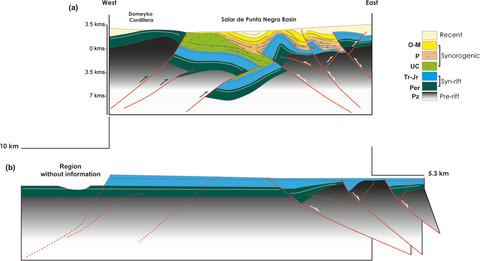当前位置:
X-MOL 学术
›
Basin Res.
›
论文详情
Our official English website, www.x-mol.net, welcomes your
feedback! (Note: you will need to create a separate account there.)
Effects of pre‐orogenic tectonic structures on the cenozoic evolution of andean deformed belts: Evidence from the salar de punta negra basin in the central andes of northern chile
Basin Research ( IF 2.8 ) Pub Date : 2020-02-11 , DOI: 10.1111/bre.12436 Fernando Martínez 1 , Cristopher López 1 , Mauricio Parra 2
Basin Research ( IF 2.8 ) Pub Date : 2020-02-11 , DOI: 10.1111/bre.12436 Fernando Martínez 1 , Cristopher López 1 , Mauricio Parra 2
Affiliation

|
[Abstract We integrated new field observations, two‐dimensional (2‐D) seismic profiles and new and previously reported chronological data to understand the effects of pre‐orogenic structures on the tectonic evolution of the Salar de Punta Negra in the Central Andes. For first time a series of restored geological cross‐sections are presented, thus showing the pre‐orogenic tectonic architecture of the region and new ideas about the tectonic evolution of the inner forearc of the Central Andes. Our results show a series of east‐dipping normal faults as the main pre‐orogenic structures in the region, which resulted from lithospheric stretching of the western continental margin during the Paleozoic to Mesozoic (Triassic–Jurassic). These were later incorporated into the Andean orogen by tectonic inversion, forming west‐verging inversion anticlines. The beginning of the tectonic inversion is constrained by the first on‐lap of the Upper Cretaceous‐Palaeocene syn‐kinematic deposits on the top of the Mesozoic syn‐rift successions, highlighting that inversion occurred during this period. These syn‐kinematic deposits display zircons with older age peaks between ca. 200 and 300 Ma, thus indicating that some Carboniferous to Triassic sources of sediments were eroded during the uplift of the orogen. Other basement reverse faults affect the footwalls of normal inverted faults and the shoulders of ancient half‐graben structures. These truncate and decapitate previous inverted faults and completely cut the infill of the basin, leading to exhumation of the pre‐rift basement rocks. We propose that the propagation of these structures was favoured by the modified thermal‐tectonic state of the lithosphere from the eastward migration of the volcanic arc, and not by the previous pre‐orogenic structures. The structural and stratigraphic relationships recognized both in the field and 2‐D seismic profiles indicate that many reverse faults originated after the initial tectonic inversion and continued to be active from the Eocene until the Pleistocene period., Geological cross‐section elaborated from the integration of field data and the two‐dimensional seismic and structural interpretation the 2F002 seismic profile and pre‐shortening restoration showing the initial geometry of the west‐dipping pre‐orogenic Paleozoic and Mesozoic extensional system under the Salar de Punta Negra Basin. Pz: Paleozoic pre‐rift basement, Per: Permian syn‐rift, Tr: Triassic syn‐rift, Jr: Jurassic syn‐rift, UC: Upper‐Cretaceous syn‐ kinematic, P: Paleocene syn‐kinematic, O‐M: Oligocene‐Miocene synkinematic. ]
中文翻译:

造山前构造构造对安第斯变形带新生代演化的影响:来自智利北部安第斯山脉中部的蓬塔内格拉盆地的证据
[摘要 我们整合了新的野外观测、二维 (2-D) 地震剖面和新的和以前报道的年代数据,以了解造山前结构对安第斯中部蓬塔内格拉盐湖构造演化的影响。首次展示了一系列修复后的地质剖面图,展示了该地区造山前的构造结构和中安第斯弧内前弧构造演化的新思路。我们的研究结果表明,一系列东倾正断层是该地区主要的前造山构造,是古生代至中生代(三叠纪-侏罗纪)西部大陆边缘岩石圈伸展的结果。这些后来通过构造反转并入安第斯造山带,形成西侧反转背斜。构造反转的开始受上白垩统-古新世同动力沉积在中生代同裂谷层序顶部的第一次上叠的制约,突出了这一时期发生的反转。这些同运动沉积物显示锆石的年龄峰值介于约 200 和 300 Ma,因此表明在造山带抬升期间,一些石炭纪至三叠纪沉积物源受到侵蚀。其他基底逆断层影响正倒断层的下盘和古半地堑构造的肩部。这些截断和斩断先前的倒断层并完全切割盆地的填充物,导致裂谷前基底岩石的剥露。我们提出,这些结构的传播受到了火山弧向东迁移导致的岩石圈热构造状态的改变,而不是以前的造山前结构的影响。现场和二维地震剖面中的构造和地层关系表明,许多逆断层起源于初始构造反转之后,并从始新世一直活动到更新世。现场数据和二维地震和结构解释 2F002 地震剖面和预缩短恢复显示了 Salar de Punta Negra 盆地下西倾的造山前古生代和中生代伸展系统的初始几何形状。Pz:古生代裂谷前基底,Per:二叠纪同裂谷,Tr:三叠纪同裂谷,Jr:侏罗纪同裂谷,UC:上白垩纪同运动,P:古新世同运动,O-M:渐新世-中新世同运动。]
更新日期:2020-02-11
中文翻译:

造山前构造构造对安第斯变形带新生代演化的影响:来自智利北部安第斯山脉中部的蓬塔内格拉盆地的证据
[摘要 我们整合了新的野外观测、二维 (2-D) 地震剖面和新的和以前报道的年代数据,以了解造山前结构对安第斯中部蓬塔内格拉盐湖构造演化的影响。首次展示了一系列修复后的地质剖面图,展示了该地区造山前的构造结构和中安第斯弧内前弧构造演化的新思路。我们的研究结果表明,一系列东倾正断层是该地区主要的前造山构造,是古生代至中生代(三叠纪-侏罗纪)西部大陆边缘岩石圈伸展的结果。这些后来通过构造反转并入安第斯造山带,形成西侧反转背斜。构造反转的开始受上白垩统-古新世同动力沉积在中生代同裂谷层序顶部的第一次上叠的制约,突出了这一时期发生的反转。这些同运动沉积物显示锆石的年龄峰值介于约 200 和 300 Ma,因此表明在造山带抬升期间,一些石炭纪至三叠纪沉积物源受到侵蚀。其他基底逆断层影响正倒断层的下盘和古半地堑构造的肩部。这些截断和斩断先前的倒断层并完全切割盆地的填充物,导致裂谷前基底岩石的剥露。我们提出,这些结构的传播受到了火山弧向东迁移导致的岩石圈热构造状态的改变,而不是以前的造山前结构的影响。现场和二维地震剖面中的构造和地层关系表明,许多逆断层起源于初始构造反转之后,并从始新世一直活动到更新世。现场数据和二维地震和结构解释 2F002 地震剖面和预缩短恢复显示了 Salar de Punta Negra 盆地下西倾的造山前古生代和中生代伸展系统的初始几何形状。Pz:古生代裂谷前基底,Per:二叠纪同裂谷,Tr:三叠纪同裂谷,Jr:侏罗纪同裂谷,UC:上白垩纪同运动,P:古新世同运动,O-M:渐新世-中新世同运动。]











































 京公网安备 11010802027423号
京公网安备 11010802027423号